From universal profiles to universal scaling laws in X-ray galaxy clusters
Vol. 644
3. Cosmology
From universal profiles to universal scaling laws in X-ray galaxy clusters
The properties of galaxy clusters are shaped mainly by gravity and astrophysical dissipative processes and show remarkable universal behavior once they are rescaled by halo mass and redshift. In this work, the authors show that a universal pressure profile of the intracluster medium (ICM) combined with a halo–mass concentration–redshift relation and the hydrostatic equilibrium equations allow for the reconstruction of the radial profiles of the thermodynamical quantities. When they are integrated over a characteristic scale (such as the commonly used R500 radius), as was done in the observations, they produce the most important physical quantities for characterizing clusters, that is to say, the total mass, gas mass, temperature, and so on. These quantities in turn satisfy universal scaling laws. Using a large sample of clusters from the Planck observations, which have homogeneous X-ray data, the authors calibrate the predicted scaling laws. Their model not only reproduces the observed scaling laws well, but it also provides a way to interpret possible deviations from this self-similar behavior of galaxy clusters. For example, this comparison allows for the quantification of the effect of gas clumping on the studied sample.
MIRACLES: atmospheric characterization of directly imaged planets and substellar companions at 4-5 μm. II. Constraints on the mass and radius of the enshrouded planet PDS 70 b (Stolker et al.)
Vol. 643
10. Planets and planetary systems
MIRACLES: atmospheric characterization of directly imaged planets and substellar companions at 4-5 μm. II. Constraints on the mass and radius of the enshrouded planet PDS 70 b
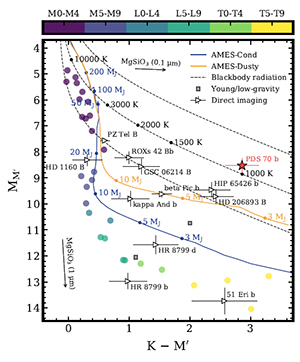
The young (~5 Myr) T Tauri star PDS 70 is an emblematic object for the study of planetary formation. It holds a gapped circumstellar disk in which two embedded planets (PDS 70 b and c) have been directly imaged and show evidence for gas accretion through detection of H alpha emission. The atmospheric and circumplanetary characteristics of these accreting young planets remain poorly understood, and a previous study of the spectral energy distribution of PDS 70 b has suggested a possible combination of emission from a planet atmosphere and a circumplanetary disk. Using VLT/NACO, Stolker et al. report the first detection of PDS 70 b in the Brα and M' filters as well as a tentative detection of PDS 70 c in Brα. PDS 70 b appears significantly redder than any previously imaged planets and brown dwarfs in the color (K-M') - magnitude (M') diagram. Fitting the resulting 1-5 um spectral energy distribution leads to a photospheric temperature Teff = 1193 +/- 20 K and a photospheric radius R = 3.0 +/- 0.2 R_J. In addition, by comparing the object's luminosity with predictions from planet structure models, and taking into account the accretion luminosity as constrained by H alpha, the authors were able to constrain the mass of PDS 70 b to Mp ≈ 0.5–1.5 M_J and its physical radius to Rp ≈ 1–2.5 R_J. The discrepancy between the photospheric and planetary radii may indicate that the planet is embedded in an extended dusty environment, muting molecular features in the object's spectrum, which implies that PDS 70 b not only accretes gas but is also continuously replenished by dust.
Common-envelope evolution with an asymptotic giant branch star (Sand et al.)
Vol. 643
7. Stellar structure and evolution
Common-envelope evolution with an asymptotic giant branch star
Common envelope evolution is an unresolved problem in binary evolution and a key for the formation of double compact objects. Hydrodynamic simulations show that the orbital energy released during spiral-in is not able to eject the complete envelope. The recombination energy of hydrogen and helium has long been proposed to play a crucial role during the ejection process. The authors carried out three-dimensional hydrodynamic simulations to study the common envelope evolution of a 1Msol early-AGB star with companions of different masses. They clearly demonstrate how recombination energy works to eject the complete envelope.
Detection of the Geminga pulsar with MAGIC hints at a power-law tail emission beyond 15 GeV
Vol. 643
1. Letters to the Editor
Detection of the Geminga pulsar with MAGIC hints at a power-law tail emission beyond 15 GeV
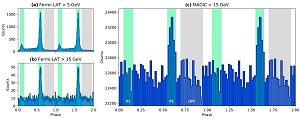
Geminga is the archetypal gamma-ray pulsar with no radio emission. Geminga has been observed up to 30 GeV by the Large Area Telescope (LAT) onboard the Fermi satellite. Previous attempts to detect Geminga by ground-based Cherenkov telescopes were unsuccessful. New observations carried out with the MAGIC telescope have succeeded in revealing a pulsed signal from Geminga up to 75 GeV. Modeling of the spectrum indicates that we are observing Geminga nearly perpendicularly to its rotation axis.
The spatially resolved broad line region of IRAS 09149-6206 (GRAVITY Collaboration)
Vol. 635
4. Extragalactic astronomy
The spatially resolved broad line region of IRAS 09149-6206

The GRAVITY collaboration reports on near-infrared interferometric spectra of the Br-gamma line, resolving the broad line region (BLR) of a nearby active galaxy nucleus (AGN). They are able to measure the size of the BLR (radius 0.075pc) and estimate the mass of the black hole (10^8 M_sun). These results are compatible with average values that have been measured in nearby AGNs through reverberation mapping as well as with the standard M_BH-sigma relation. A surprising result is the 0.14 pc offset between the BLR and the centroid of the hot dust distribution, which is traced by the 2.3 micron continuum. The hot dust is thought to be distributed in a ring, with a measured radius of 0.35 pc, since the high temperature inside the ring sublimates the dust. The offset falls well inside the ring and is thought to be due to the brightness asymmetry of the ring. A clear velocity gradient, almost perpendicular to the offset, is interpreted as the Keplerian rotation of the BLR.
Understanding and improving the timing of PSR J0737-3039B (Noutsos et al.)
Vol. 643
7. Stellar structure and evolution
Understanding and improving the timing of PSR J0737-3039B
The double pulsar (PSR J07373039A/B) is the only known system consisting of two radio pulsars in a 2.5hr orbit. Given its unique characteristics, and thanks to its incredible inclination of 89 degrees, it is our best laboratory for general relativity studies. Past studies have concentrated on pulsar A, a recycled millisecond pulsar spinning at 23 ms. Pulsar B is a normal pulsar spinning at 2.8 s. Being less powerful by a factor of ~3500, pulsar B is heavily embedded in the relativistic wind of pulsar A. In this paper, Noutsos and collaborators study pulsar B in detail, notably its emission during the time interval 2004-2008 when the pulsar was detectable before moving away from the line of sight due to geodetic precession. They have developed a model for the pulsar emission beam and its interaction with pulsar A's wind, and they make predictions for 2024 when pulsar B should become visible again. This will allow for more precise testing of the geodetic precession.
The solar gravitational redshift from HARPS-LFC Moon spectra. A test of the general theory of relativity (Gonzalez Hernandez et al.)
Vol. 643
13. Astronomical instrumentation
The solar gravitational redshift from HARPS-LFC Moon spectra. A test of the general theory of relativity

The general theory of relativity predicts that the wavelengths of solar spectrum lines should be shifted redwards compared to laboratory wavelengths by about 633 m/s in velocity scale. However, the competing blueshift due to granulation phenomena produced by convection makes an accurate observational test of this prediction extremely challenging. This paper presents the most accurate measurement of the solar gravitational redshift to date. The authors employed the laser frequency comb calibration system attached to the HARPS spectrograph on the ESO 3.6 m telescope at La Silla and observations of the sunlight reflected off the moon. State-of-the-art 3D hydrodynamical models of the solar atmosphere were then employed to analyze the spectral lines and measure an accurate gravitational redshift value, which is in full agreement with the theoretical prediction.
Tracing the total molecular gas in galaxies: [CII] and the CO-dark gas (Madden et al.)
Vol. 643
4. Extragalactic astronomy
Tracing the total molecular gas in galaxies: [CII] and the CO-dark gas
The CO molecule is the tracer of choice for inferring the amount of star-forming molecular hydrogen gas in our Galaxy and other galaxies with similar metallicities. In low-metallicity systems like dwarf galaxies, however, CO can fail to trace the full reservoir of H2 due to the presence of large quantities of molecular gas where CO has been photodissociated by penetrating far ultra-violet radiation. To account for this CO-dark gas, Suzanne Madden and collaborators have systematically studied the use of CII. Using grids of Cloudy models that span a variety of physical conditions and metallicities, these authors provide recipes for deriving total H2 mass estimates from CII observations. Using these models, they find that 70% to 100% of the total H2 mass in dwarf galaxies is not traced by CO(1-0) but is well traced by the λ 158 μm line of CII. When this CO-dark gas is accounted for, the dwarf galaxies are found to follow the same Schmidt-Kennicutt relation identified in more metal-rich disk galaxies.
A physical model for the magnetosphere of Uranus at solstice time (Pantellini)
Vol. 643
10. Planets and planetary systems
A physical model for the magnetosphere of Uranus at solstice time
The magnetosphere of Uranus is subject to strong seasonal variations. The variability is a consequence of the planet's rotation axis being nearly parallel to its orbital plane, a situation unique in the Solar System. A short rotation period of 17.24h and a large angle between the rotation axis and magnetic dipole axis induces a twist of the planetary magnetic field lines, which are forced to expand downstream of the planet under the action of the supersonic solar wind. Numerical simulations suggest the scale of the twist to be of the order of several hundred times the Uranian radius. Specifically, for the solstice case, simulations show that the planetary field lines expanding downstream of the planet become organized into two distinct interlaced helically structured bundles. This paper presents a detailed physical description of this tail structure for a Uranus-like magnetosphere at solstice, when the solar wind and the rotation axis are quasi-aligned. In a symmetrized version of the original problem, the paper describes the time evolution of a field line from its emergence through the planet's surface to its final position. It shows, for example, that in the planet frame, the asymptotic position is a unique one-dimensional static double helix, independently of the field line's emergence point. It also shows that each strand of a field line approaches its asymptotic position along a spiraling path, similarly to the path followed by a fluid parcel in a tornado.
Dust and gas in the central region of NGC 1316 (Fornax A). Its origin and nature (T. Richtler)
Vol. 643
4. Extragalactic astronomy
Dust and gas in the central region of NGC 1316 (Fornax A). Its origin and nature
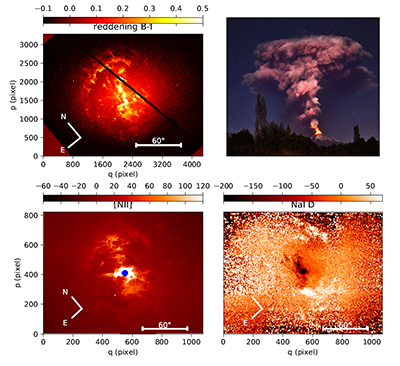
The central galaxy of the Fornax cluster, NGC 1316, is an early-type galaxy that hosts the radio source FornaxA. NGC 1316 reveals a perturbed dust structure within a 5kpc radius as well as gas that is probably accreted from a merger. Using archival HST/ACS color data and MUSE maps of the ionized gas, the authors studied the central stellar population as well as neutral (NaI D-lines) and ionized ([NII]) velocity fields. The excitation of the ionized gas is thought to come from the post-AGB stars of the old- and intermediate-age stellar population. In the dust-free regions, the interstellar NaI D lines appear in emission, which is indicative of a galactic wind. In the very center, a bipolar velocity field of the ionized gas is observed, which is interpreted as an outflow. There is also an almost edge-on gas and/or dust disk along the major axis of NGC 1316. The dust in NGC 1316 appears to have different origins. There exists an outflow that is curved along the line-of-sight. Nuclear outflows may be important dust-producing machines in galaxies. The dusty gaseous disk looks to be a predecessor for a central dust lane.
Parsec-scale properties of the radio brightest jetted AGN at z >6 (Spingola et al.)
Vol. 643
1. Letters
Parsec-scale properties of the radio brightest jetted AGN at z >6
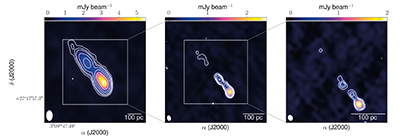
Blazars are powerful quasars with accretion disks that are nearly face-on. Additionally, their light beams and radio jets are approximately located along the line of sight and thus experience Doppler boosting. They tend to be under-abundant at high redshift with respect to the local universe. The authors report on the very long baseline interferometry of the most powerful jetted active galactic nuclei at z>6. Using milliarcsecond resolution, they discovered a bright one-sided jet about 500 pc long in projection that is resolved into multiple clumps. They derived its viewing angle as well as its Lorentz and Doppler factors. Surprisingly, its bulk Lorentz factor appears to be relatively low (less than 5), which might explain the paucity of high-z blazars with respect to current predictions. However, other scenarios have not been ruled out. More stringent constraints on this jet and other high-z blazars will be needed to form conclusions regarding the possible z-evolution of the blazar population.
A stringent upper limit of the PH3 abundance at the cloud top of Venus
Vol. 643
1. Letters to the Editor
A stringent upper limit of the PH3 abundance at the cloud top of Venus
A recent candidate detection of the phosphine molecule (PH3) with JCMT and ALMA in the upper atmosphere of Venus has incited a great deal of public interest. Phosphine is not expected to survive long in the highly oxidizing atmosphere of Venus, and its tentative detection has therefore been speculated to reflect biological processes in the Venusian atmosphere. Encrenaz et al. use observations of a 10 micrometer transition of phosphine to set an upper limit on its abundance at and slightly above the top of the Venus clouds. That limit is, at the 3 sigma confidence level, a factor of four lower than the PH3 abundance derived from the tentative millimeter-wave detection. The millimeter-wave transition of PH3 probes higher levels of the Venus atmosphere than the 10 micrometer transition, leaving the two results formally compatible; however, the tight upper limit obtained by Encrenaz et al. sets very strong constraints on phosphine production in Venus.Modeling protoplanetary disk SEDs with artificial neural networks. Revisiting the viscous disk model and updated disk masses
Vol. 642
6. Interstellar and circumstellar matter
Modeling protoplanetary disk SEDs with artificial neural networks. Revisiting the viscous disk model and updated disk masses
There are still several open questions in our understanding of planet formation, including the main mechanism responsible for angular momentum transport in protoplanetary disks or their apparent low masses compared to those of exoplanetary systems. Investigating these types of issues requires disk models that account for many physical processes, which also makes them computationally demanding. As a result, modeling large samples of disks can usually only be achieved with simpler models. In this work, Ribas et al. combine physically motivated viscous disk models with artificial neural networks to drastically speed up their computation times, which allows for modeling of spectral energy distributions of protoplanetary disks with detailed models using a Bayesian framework. Applying this approach to 23 protoplanetary disks in the Taurus-Auriga star-forming regions yields high viscosity values for many of them, which is in contradiction with recent ALMA results. This suggests that mechanisms other than viscosity could play a significant role in the transport of angular momentum in disks. The disk masses derived using full radiative transfer models are also systematically higher than those derived from (sub)mm fluxes alone, which could help alleviate the observed discrepancy between the masses of disks and exoplanetary systems.
A global model of particle acceleration at pulsar wind termination shocks
Vol. 642
2. Astrophysical processes
A global model of particle acceleration at pulsar wind termination shocks
Pulsar wind nebulae are among the brightest Galactic nonthermal sources at high energies, up through TeV, testifying to the efficient acceleration of charged particles in the vicinity of the central neutron star. Determining how to reach the required energies has been a challenging problem for decades. This study uses a schematic but physically plausible representation of the latitude-dependent pulsar wind and magnetic field into which leptons (electron-positron) are injected. The time dependent flow forms a shock, whose structure rapidly becomes macroscopically turbulent. The simulation uses a fully relativistic particle-in-cell (PIC) code, Zeltron, to follow the diffusive particle energization through this tangle of filamented structures at the termination shock of the wind with its surrounding interstellar medium (ISM). The formation of the shock over time is a result of the simulation and it is not pre-imposed, hence the complex structure development can be followed. This is perhaps the most intriguing result of the modeling, that is to say the synchrotron emission in different energy ranges is diagnostic for the site of origin: The highest energy emission comes from the turbulent regions imbedded within shock cavities and it is boosted and beamed by the local bulk motions at the shock.
ROSINA ion zoo at Comet 67P
Vol. 641
10. Planets and planetary systems
ROSINA ion zoo at Comet 67P

Popularized as the "cometary Zoo,” the richness of cometary neutral composition has been revealed at comet 67P Churyumov-Gerasimenko by the ROSINA instrument on board ESA's Rosetta mission. The ionization of neutrals by extreme ultraviolet radiation and energetic electrons produces cometary ions, whose subsequent reactions and collisions with neutrals may further enrich ion composition. Cometary atmosphere ionosphere models have thus predicted a whole suite of cometary cations, but remote sensing detections have been relatively scarce, and earlier in situ mass spectrometry on Giotto had insufficient mass resolution to distinguish between ion species of a similar mass. The situation has dramatically changed with the operation of ROSINA at comet 67P with a mass resolution of up to 3000, permitting, for example, one to distinguish 13C+ from CH+. Here, Beth et al. report on the detailed composition of the ionosphere of comet 67P, establishing the presence of many predicted catio! ns such a s CH_m+ (m = 1-4), H_nO (n=1-3), O+, Na+, and several ionized and protonated molecules (e.g., C2H4+, C2H5+, and CH3OH2+). A particular highlight is the discovery of CO2++, which was produced by the direct ionization of CO2, which represents the first detection of a molecular dication in any gas envelope in the Solar System.
The path to instability in compact multi-planetary systems
Vol. 641
10. Planets and planetary systems
The path to instability in compact multi-planetary systems

Three or more compact planetary systems can become unstable on timescales of up to billions of years. Predicting their stability is challenging and numerically expensive due to the chaotic dynamics, and, until now, there has been no theoretical understanding of the nature of the mechanism driving the instability. Based on numerical simulations, it had been postulated that the system's survival time follows an exponential trend in the planet orbital separation measured in units of Hill radii. Contrary to a constant diffusion process, planetary systems seem to remain dynamically quiescent for most of their lifetimes prior to a very short unstable phase. In this work, Petit and colleagues study a two-phase mechanism in which the slow chaotic diffusion due to the overlap of three-body resonances dominates the instability timescale prior to a rapid scattering phase triggered by the crossing of a two-planet mean motion resonance. They obtain an analytical estimate of the survival time that is consistent with numerical simulations over four orders of magnitude for the planet-to-star mass ratio, and six to eight orders of magnitude for the instability time. They also confirm that measuring the orbital spacing in terms of Hill radii is not suitable and that the correct spacing unit scales have a flatter dependency in the planet mass. Their model reproduces the observation that the survival time increases beyond a certain spacing since the three-planet resonances do not overlap.
Observed binary populations reflect the Galactic history
Vol. 641
10. Planets and planetary systems
Observed binary populations reflect the Galactic history
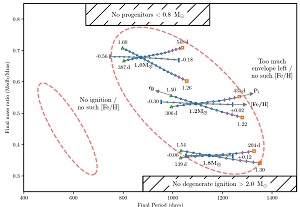
The authors demonstrate, for the first time, that the observed orbital period-mass ratio correlation of subdwarf B (sdB) binaries is caused by the metallicity history of our Galaxy. Metal-rich low-mass stars have larger radii at the tip of the first giant branch (FGB) than metal-poor low-mass stars. Consequently, the stable mass transfer of a metal-rich low-mass donor star ascending to the tip of the FGB leads to the formation of sdB binaries with longer orbital periods. The narrow sdB mass range, the narrow mass ratio range in the original binaries which lead to sdBs, and the Galaxy chemical evolution model, therefore, create the observed strong P-q correlation. We may see similar metallicity effects for other binaries which resulted from stable mass transfer of low-mass red giant donors, and we may expect that the accurately measured properties of the low-mass exotic binaries will provide new constraints on chemical evolution studies of the Galaxy.
The First Billion Years project: Finding infant globular clusters at z=6 ( Phipps et al.)
Vol. 641
5. Galactic structure, stellar clusters and populations
The First Billion Years project: Finding infant globular clusters at z=6
Globular clusters (GCs) are among the oldest gravitationally bound stellar systems as they are characterized by stellar populations with ages of 11.5 to 12.5 Gyr. They probably formed during, or just after, the epoch of reionization; therefore, the study of these systems at high redshift cannot only give insight into the processes and environments that governed star formation at that time, but they can also represent valuable probes of the reionization epoch itself. In this work, the authors conduct an analysis of the demographics and global properties of low-mass stellar systems at high redshift, within the numerical framework of the FiBY cosmological simulations. They identify a population of dense objects with M*<10^4 Msolar, such that the fraction of baryons (over the total mass of baryons and dark matter) is close to unity; they suggest that these objects are possible infant GC candidates. Compared to present-day GCs in the local Universe, these infant GCs have a higher gas fraction and consistently appear to be more extended with the properties of the few examples of proto-globulars currently observed at high-redshift. Forthcoming studies will examine the origin and future evolution of these systems to further progress our understanding of the role of low-mass stellar systems in early galaxy formation.Signatures of ubiquitous magnetic reconnection in the lower solar atmosphere (Joshi et al.)
Vol. 641
9. The Sun and the Heliosphere
Signatures of ubiquitous magnetic reconnection in the lower solar atmosphere
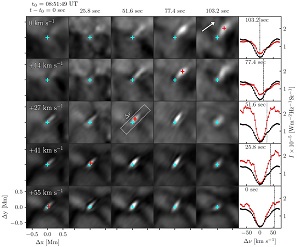 Magnetic reconnection is a fundamental physical process that governs a variety of high energy dynamics in the solar atmosphere, such as flares and coronal mass ejections. In the lower solar atmosphere, small-scale magnetic reconnection manifests as intense and compact brightenings in the wings of the hydrogen Balmer-a line; these manifestations are known as Ellerman bombs. Ellerman bombs are constituents of magnetically active solar regions and magnetic flux-emerging regions. Very recently, a phenomenon analogous to Ellerman bombs was discovered in regions of minimal magnetic activity on the solar surface, the quiet Sun, and termed as quiet Sun Ellerman bombs. Quiet Sun Ellerman bombs are the smallest observable magnetic reconnection phenomenon in the lower solar atmosphere. In this Letter, the authors, using high spatial resolution observations in the hydrogen Balmer-b line from the Swedish 1-m Solar Telescope, report that quiet Sun Ellerman bombs are ubiquitous and nearly uniformly distributed throughout the solar surface; there could be about half a million quiet Sun Ellerman bombs on the solar surface at any given time. The presented observations indicate that the magnetic reconnection leading to quiet Sun Ellerman bombs takes place in vertically extended current-sheets in intergranular lanes extending between the photosphere and chromosphere. It will be of great interest to study the role of this ubiquitous small-scale magnetic reconnection phenomenon in chromospheric and coronal heating.
Magnetic reconnection is a fundamental physical process that governs a variety of high energy dynamics in the solar atmosphere, such as flares and coronal mass ejections. In the lower solar atmosphere, small-scale magnetic reconnection manifests as intense and compact brightenings in the wings of the hydrogen Balmer-a line; these manifestations are known as Ellerman bombs. Ellerman bombs are constituents of magnetically active solar regions and magnetic flux-emerging regions. Very recently, a phenomenon analogous to Ellerman bombs was discovered in regions of minimal magnetic activity on the solar surface, the quiet Sun, and termed as quiet Sun Ellerman bombs. Quiet Sun Ellerman bombs are the smallest observable magnetic reconnection phenomenon in the lower solar atmosphere. In this Letter, the authors, using high spatial resolution observations in the hydrogen Balmer-b line from the Swedish 1-m Solar Telescope, report that quiet Sun Ellerman bombs are ubiquitous and nearly uniformly distributed throughout the solar surface; there could be about half a million quiet Sun Ellerman bombs on the solar surface at any given time. The presented observations indicate that the magnetic reconnection leading to quiet Sun Ellerman bombs takes place in vertically extended current-sheets in intergranular lanes extending between the photosphere and chromosphere. It will be of great interest to study the role of this ubiquitous small-scale magnetic reconnection phenomenon in chromospheric and coronal heating.
Fully compressible simulations of waves and core convection in main-sequence stars (Horst et al.)
Vol. 641
2. Astrophysical processes
Fully compressible simulations of waves and core convection in main-sequence stars
Turbulent core convection provides one mechanism to excite stellar oscillations (e.g. internal gravity waves) that amplify and disperse in the interior as they propagate. The corresponding surface wave spectra and signatures are still being debated within current investigations using multidimensional hydrodynamical simulations. While many approaches use a modified version of the equations of hydrodynamics as a basis for modeling, the method presented in the paper also accounts for compressibility effects and is thus able to recover acoustic waves in addition to internal gravity waves.


